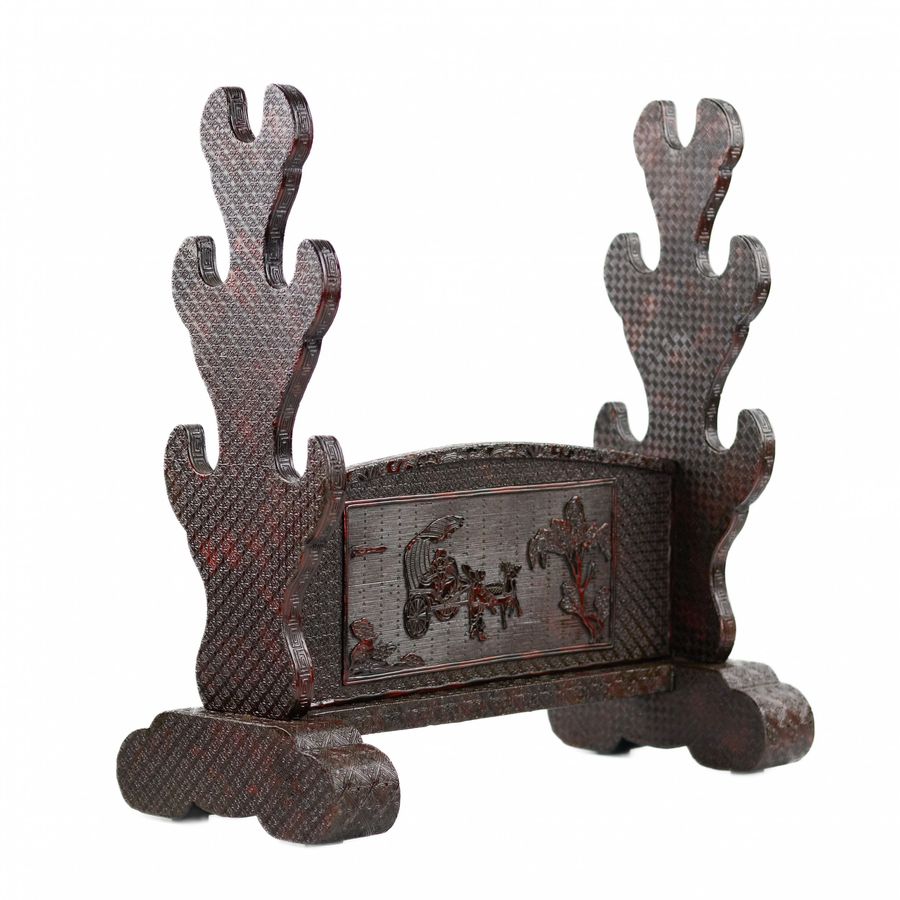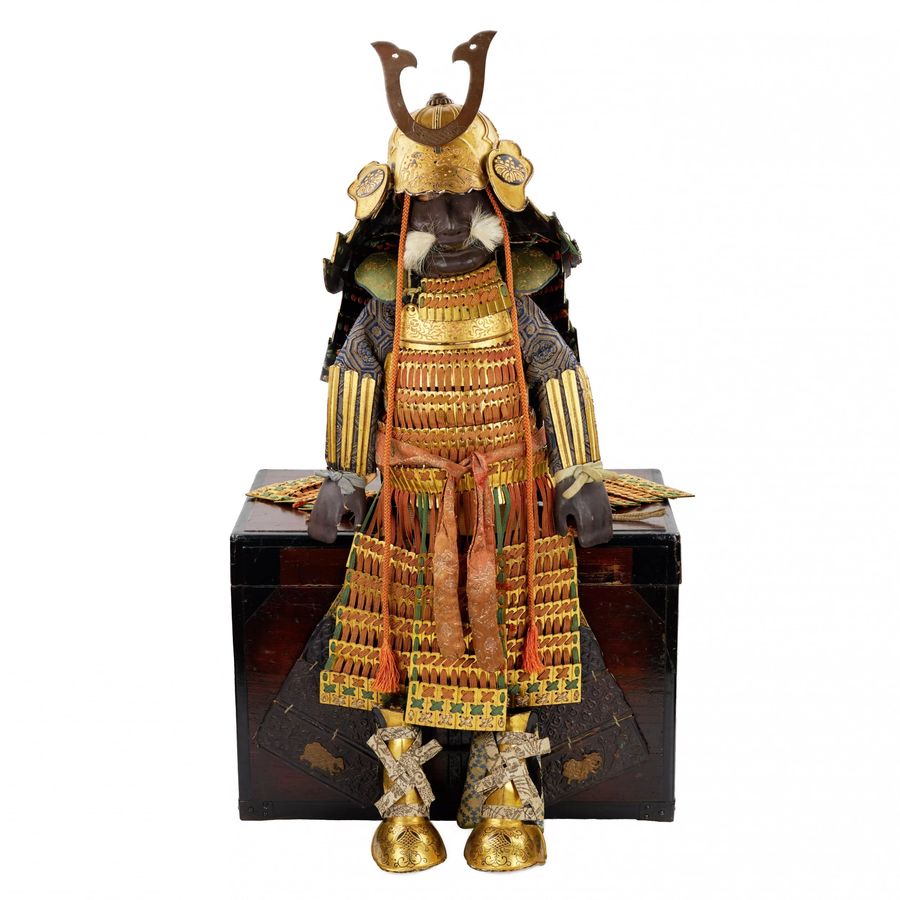antique arms & armour: weapons
Antique weapons designed for inflicting bodily harm or physical damage such as knives, swords, cutlasses, guns, bows, arrows, maces, etc.
-
TRIBAL RIFLE ZEZAIL KYBER PASS WITH TOWER LOCK
bore park antiques, nuneaton, united kingdom
Pashtun tribe The real thing, not fancy display but the genuine thing also note the Brown Bess Lock that still works, length in total 128 cm width being 18 cm depth of 8 cm, offering...
£995.00
view details -
Honorary Cossack saber marked with the sign of the Ice March of 1918. Russia
sia antion, riga, latvia
Honorary Cossack saber marked with the sign of the Ice Campaign of 1918 with a memorial inscription to Lieutenant Manukhin Manukhin Nikolai Alexandrovich. Lieutenant. In the Volunteer Army. Participant of the 1st Kuban campaign. The blade is bare with the manufacturers mark. The hilt, scabbard and fittings are decorated with blackened silver, with an applied silver sword badge within a crown of thorns See Converted badges from the Volunteer Army order. Historical background: 1st Kuban Campaign (Ice) - the first campaign of the Volunteer Army to Kuban during the Civil War (February 9 (22) - April 30 (May 13), 1918). September 21 (October 4), 1918 by order of the commander The volunteer army of Lieutenant General A.I. Denikin in memory of the First Kuban (Ice) Campaign established the “Insignia of the First Kuban Campaign.” The reward was a silver crown of thorns, crossed from bottom to top by a silver sword. Width: 10cm, Height: 92cm, Depth: 4cm, Weight: 1kg, Condition: Signs of wear commensurate with age, Material: Blacking, ID: 8657
£6,345.71
view details -
Blunderbuss 1750’s flintlock English
bore park antiques, nuneaton, united kingdom
Excellent gun actions firm and working as it should probable stagecoach gun has the odd marks of time but still a fine weapon to hold, the metal work has some tarnish all over but no...
£1,500.00
view details -
Caucasian saber with gilded silver and ivory decor. Russia. 19th century.
sia antion, riga, latvia
Caucasian saber with gilded silver and bone decoration. The blade is bare, engraved on one side. Handle with silver fittings with niello ornament and bone inlay. The scabbard also has silver fittings, blackened ornaments and bone inlay. Russia, 19th century. Width: 9cm, Height: 104cm, Depth: 3cm, Weight: 2kg, Condition: Good, Material: Ivory, ID: 8656
£5,499.62
view details -
A pair of dueling pistols from the court gunsmith of Nicholas I - Bertrand. Saint Petersburg. Mid...
sia antion, riga, latvia
A wonderful pair of cased, dueling pistols, the court gunsmith of Nicholas I, Jacob Bertrand, mid-19th century. Octagonal, smoothbore, 11 gauge pistols with fine, gilded engraving of floral motifs, Bertrand St. Petersburg - on the top of the barrel. Markings and serial numbers 205.1 and 205.2 on the bottom of the barrels. Finely crafted wooden handles. Complete set of tools for cleaning and loading. Packed in an original turnkey wooden box with brass decor. High quality cloth interior trim. Gun length: 44 cm. Jacob Bertrand (? - 1849 (?), court and naval departmental gunsmith. In 1830 he started a business in Russia. In 1835–1840 he worked for Javale. At the Moscow exhibition of 1835 he exhibited guns and pistols, at the St. Petersburg exhibition of 1849 - hunting rifles . and the State Historical Museum. Width: 31cm, Height: 50cm, Depth: 8.5cm, Weight: 15kg, Condition: Good, Material: Wood, metal, ID: 8511
£12,268.38
view details -
Horse whip/dagger
bore park antiques, nuneaton, united kingdom
Leather whip steel dagger condition good length of 53 cm from steel tip to top of handle being 44 cm, offering free delivery UK reference FRGC Tel: +44 7505 165 843 We accept online payments...
£245.00
view details -
Blunderbuss James Freeman London
bore park antiques, nuneaton, united kingdom
Brass barrel flintlock George 11 in very good condition and fully working order proof marks name along barrel and plate for James Freeman a renowned Gunsmith of that era, length of 76 cm height 16...
£2,750.00
view details -
MUZZLE LOADER GENTLEMAN’S SPORTING PERCUSSION RIFLE
bore park antiques, nuneaton, united kingdom
Sadly needing restoration so just now only fit for hanging on ones wall, was once an exceptional musket, offering free UK delivery reference LC3 Tel: +44 7505 165 843 We accept online payments for all...
£245.00
view details -
Decorative knight&39;s armor made of wrought iron. Germany. 19th-20th century.
sia antion, riga, latvia
Knight armour. Wrought iron. Historical and detailed knight`s armor on a wooden support and base. Helmet with neck strap, folding visor and neck protection. Cuirass with sleeves and plate apron. Shoulders, elbow pads, armor gloves. Knee pads and leg protection. Engraved decoration with stylized scrolls of leaves, partially heads of dragons and horsemen, as well as stylized coats of arms. Total height 190 cm. Decorative knight`s armor made of wrought iron with engraving on the pedestal. Germany. 19th-20th century. Weight 35 kg. Width: 80cm, Height: 190cm, Depth: 50cm, Weight: 40kg, Condition: Good, Material: Metal, ID: 8808
£6,345.71
view details -
ICHIMONJI JINGASA. Samurai hat. Periodo Edo (1603-1867)
sia antion, riga, latvia
Lightweight, round shape, kanshitsu samurai hat. External flat, the surface is covered with black varnish with craquelure. In the front is a beautiful golden sign: Maru-ni-mitsu-ohgi-mon (three fans in a circle), on the sides are two kanji Hayashi (indicating the name of the samurai). Red lacquer interior with raised hem, complete with futon and lined drawstrings. Diameter: 42cm. Width: 42cm, Height: 42cm, Depth: 10cm, Weight: 1kg, Condition: Good, Material: Fabrics, ID: 7723
£592.27
view details -
Samurai armor, Edo period.
sia antion, riga, latvia
Samurai armor, Edo period. Consisting of: cuirasses - do, plate skirt - kusazuri, leggings - haidate plate skirt, sections of which could be tied around the hips forming a kind of trouser leg knee pads - tate-oge, leggings - suneate, shoulder pads - sode, bracers - kote, mittens - tekko ( half-mittens) - as a rule, it was a plate (often in the form of a stylized palm), which is part of the kote and covers the back of the hand, the helmet is kabuto, the visor is the headband - mabizashi, the contour is kosimaki, a wide plate running along the lower edge of the helmet, the back of the neck is shikoro, decoration - date, mask - mengu, on the chin (protection of the throat) - yodare-kake. The Edo period (Jap. ???? edo-jidai) is a historical period (1603-1868) of Japan, during the reign of the Tokugawa clan. It began with the appointment of Tokugawa Ieyasu as shogun in 1603. Completed by the removal of the shogun Tokugawa Yoshinobu in 1868. It is characterized as the time of the establishment of the Tokugawa dictatorship, at the same time as the transition from medieval civil strife to a completely controlled country. During the Edo period, the formation of the Japanese spirit, the emergence of the national Japanese idea, the development of the economy and the bureaucracy took place. The Edo period is the golden age of literature and Japanese poetry, Matsuo Basho is the most prominent representative of the poetry of both the Edo period and Japanese poetry in general. As a result of the sakoku self-isolation policy, for almost the entire Edo period, the country was behind the Iron Curtain, without trading or communicating with other countries (a rare exception is China and the Netherlands). Width: 60cm, Height: 177cm, Depth: 54cm, Weight: 30kg, Condition: Good, Material: Textile, ID: 6525
£5,499.62
view details -
Samurai armor, Edo period.
sia antion, riga, latvia
Samurai armor, Edo period. Consisting of: cuirass - do, plate skirt - kusazuri, legguards - haidate plate skirt, sections of which could be tied around the hips forming a semblance of pant legs, knee pads - tate-oge, leggings - suneate, shoulder pads - sode, bracers - kote, mittens - tekko (half mittens ) - as a rule, was a plate (often in the form of a stylized palm), which is part of the kote and covers the back of the hand, helmet - kabuto, visor - mabizashi, rim - koshimaki, a wide plate running along the lower edge of the helmet, back plate barmitsa - shikoro, decoration - date, mask - mengu, chin guard (throat protection) - yadare-kake.The Edo period (Japanese: ???? edo-jidai) is a historical period (1603-1868) of Japan, during the reign of the Tokugawa clan. Began with the appointment of Tokugawa Ieyasu as shogun in 1603. Completed by the resignation of shogun Tokugawa Yoshinobu in 1868. It is characterized as the time of establishment of the Tokugawa dictatorship, at the same time as a transition from medieval civil strife among daimyos to a fully controlled country. During the Edo period, the formation of the Japanese spirit, the emergence of the national Japanese idea, the development of the economy and the bureaucracy took place. The Edo period is the golden age of literature and Japanese poetry, Matsuo Basho is the most prominent representative of the poetry of both the Edo period and Japanese poetry in general. As a result of the Sakoku policy of self-isolation, for almost the entire Edo period the country was behind the Iron Curtain, not conducting trade or communicating with other countries (rare exceptions are China and the Netherlands). Width: 60cm, Height: 177cm, Depth: 54cm, Weight: 30kg, Condition: Good, Material: Textile, ID: 6524
£3,807.43
view details -
Japanese traditional Naginata spear, Shinshinto period, 1781-1876.
sia antion, riga, latvia
Japanese traditional Naginata spear, Shinshinto (Newest Era) period, 1781-1876 (also called the Late Edo period). Nagasa (blade) - 48.5 cm. Tsuba (Garda): made of bronze with a decorative three-dimensional pattern. The handle of the naginata was made of oak, varnished and often had an oval section, which made it easier to determine the direction of the blade during quick rotations and interceptions. The blade could be separated from the handle by a round tsuba guard. The blades varied: some resembled sword blades, while others widened towards the end. Sometimes reforged katana blades were used as naginata tips. Naginata has long been a favorite weapon of warrior monks. The total length of the spear is about 205 cm. Perfect for adding to your collection of Japanese weapons. Width: 5cm, Height: 205cm, Depth: 5cm, Weight: 3kg, Condition: Good, Material: Wood, metal, ID: 6523
£1,861.41
view details -
Spear of Kagi-yari. Japan. Edo period. 1781-1876
sia antion, riga, latvia
Spear of Kagi-yari. Japan, Shinshinto (Newest Era) period, 1781-1876 (also called the Late Edo period). The classic yari consists of a shaft (ebu or nagae) to which a tip (ho) is attached. The shaft is 1.8-2.5 m long, in cross section, as a rule, round or multifaceted (rather than oval), made of oak or, more rarely, bamboo. The tips were 15-90 cm long and were xiphoid in shape, fastened with a shank (nakago). They allowed to inflict stabbing and chopping blows. Thanks to these tips, yari can be classified as glaives. Sometimes a metal hadome crosspiece was made 30 cm below the tip. Tsuba was common. For more reliable fastening, the end of the shaft was supplied with a fastening sleeve (habaki) and washers (seppa). At the lower end was an undercurrent (ishizuki) that could be used to strike. The upper part of the shaft was varnished and wrapped with a cord (sen-dan-maki). Kagi-yari is a spear with a hook fixed at the base of the tip pointing forward to capture enemy weapons. Length - 205 cm. Width: 20cm, Height: 205cm, Depth: 5cm, Weight: 3kg, Condition: Good, Material: Wood, metal, ID: 6522
£1,692.19
view details -
Swedish saber, naval, officer. 1876
sia antion, riga, latvia
Swedish naval saber, officer. 1876 The gilded brass hilt with an anchor is at the same time a limiter for the engraved blade. The handle is in the shape of a lion, covered with stingray leather. Gold sewing lanyard. Leather scabbard with brass. Length: 90 cm. Width: 14cm, Height: 90cm, Depth: 14cm, Weight: 2kg, Condition: Signs of wear commensurate with age, Material: Leather, ID: 5575
£803.79
view details -
Saber of a Swedish naval officer, second half of the 19th century.
sia antion, riga, latvia
Saber of a Swedish naval officer, second half of the 19th century. Marking JON. SVENGREN EKILSTUNA. Saber in a leather sheath, with decorative brass trim. Engraved with an anchor and coat of arms of Sweden. The length of the saber is about 84 cm. The length of the blade is about 75 cm. Width: 11cm, Height: 84cm, Depth: 7.5cm, Weight: 0.963kg, Condition: Good, with traces of use, Material: Leather, ID: 5503
£719.18
view details -
Drum. Model from 1853.
sia antion, riga, latvia
Swedish Army model 1853 infantry drum. Made from copper plate with blue and yellow painted wood sides. Holes for lacing.Presumably brands: Eriksson & Brovall, Stockholm. Diameter 38 cm. Width: 38cm, Height: 24cm, Depth: 38cm, Weight: 3kg, Condition: Signs of wear commensurate with age, Material: Copper, ID: 3049
£380.74
view details -
Officers sword.
sia antion, riga, latvia
A ceremonial officers sword with a gilded hilt, with a blued and engraved blade, in a scabbard, presumably France in the 19th century, L-73cm. Width: 9cm, Height: 73cm, Depth: 4cm, Weight: 2kg, Condition: Signs of wear commensurate with age, Material: Steel, ID: 2735
£803.79
view details -
Caucasian dagger in silver. Georgia, 19th century.
sia antion, riga, latvia
Monocot Caucasian dagger, cleaver type, with an ebony handle, stylizing a kite. In a wooden, leather, sheath, decorated with blackened silver, in the form of fish scales. The blade is decorated with an image of a mountain leopard against the backdrop of the rising sun. Georgia, 19th century. Blade length: 51 cm Dagger length: 53.5 cm. Width: 5cm, Height: 53.5cm, Depth: 3cm, Weight: 0.682kg, Condition: Good, Material: Wood, metal, ID: 8501
£1,607.58
view details -
Short sword of the samurai Wakizashi, Nanki Hatakeyama, master Yamato no Suke Masatsugu, 19th cen...
sia antion, riga, latvia
Short sword of the samurai Wakizashi, Nanki Hatakeyama Yamato no Sukemasatsugu. With the imperial chrysanthemum emblem. The blade is signed and dated. Blacksmith Yamato 1840 - 1860. Nanki Hatakeyama Yamato no sukematsugu. Tsuba and Fuchi are signed. Blade size: +-64.5cm. Length of the sword in a lacquered wooden scabbard: 72 cm. Width: 8cm, Height: 71cm, Depth: 8cm, Weight: 1kg, Condition: Good, Material: Steel, ID: 8057
£3,299.77
view details -
Japanese sword. Wakizashi. 19th century.
sia antion, riga, latvia
Japanese sword. Wakizashi. 19th century. Steel blade. Wooden, in embossed leather, sheath with a bronze latch decorated with horses. Leather wicker handle, stingray skin, with bronze figures. At the end of the handle is a figurine of a tiger. Welt guard (tsuba) with flowers. Length: 71 cm. Unknown master. Width: 7cm, Height: 71cm, Depth: 6.5cm, Weight: 0.834kg, Condition: Good, Material: Wood, metal, ID: 6082
£2,369.07
view details -
Russian saber of dragoon officers.
sia antion, riga, latvia
Russian saber of dragoon officers. Model 1881-1909 On the handle is the sign of Nicholas II, a multi-purpose blade with text, black leather sheath with brass fittings. Width: 12cm, Height: 91cm, Depth: 3cm, Weight: 1.3kg, Condition: Signs of wear commensurate with age, Material: Brass, ID: 4008
£3,215.16
view details -
Webley MK 3 Triggers parts
bore park antiques, nuneaton, united kingdom
This set of Webley MK 3 Triggers is perfect for anyone looking to enhance their shooting experience. Made of heavy-duty steel, these parts are built to last and provide optimal performance. The set includes three...
£65.00
view details -
Katana stand (katana kake) in red carved lacquer, Meiji period (Japanese: ??) Japan, 19th century...
sia antion, riga, latvia
Stand for katana (katana kake) Meiji period, for 5 swords, in red carved lacquer of fine workmanship. Japan, 19th century. On a wooden panel decorated with a relief pattern of diamonds and flowers, a rectangular cartouche depicts a traditional Japanese landscape with a scene of a scientist drinking from a cart. L. 39.8 cm and H. 44 cm. Width: 43cm, Height: 44cm, Depth: 20cm, Weight: 3kg, Condition: Good, with traces of use, Material: Wood, ID: 8117
£3,553.60
view details -
Model of Japanese armor Yoroi. Periodo Meiji (1868-1912)
sia antion, riga, latvia
Model of Japanese Yoroi armor, late 19th century. With an elegant golden kabuto equipped with large fuki-gaeshi with mon. All armor features gilded black lacquer plates with orange and green lacing. The remaining elements (kote, sode, kusazuri and suneate) are also gilded and decorated with tassels. Original wooden case with metal locks. Beautiful, large, varnished bit gusoku. 34x45x28 cm. Armor height is about 84 cm. Width: 45cm, Height: 84cm, Depth: 28cm, Weight: 15kg, Condition: Good, Material: Gilding, ID: 7721
£4,653.52
view details






























